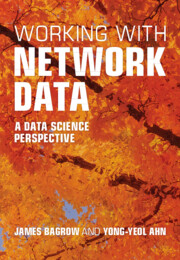Book contents
- Frontmatter
- Contents
- Preface
- Part I Background
- Part II Applications, tools, and tasks
- Chapter 5 The life cycle of a network study
- Chapter 6 Gathering data
- Chapter 7 Extracting networks from data — the “upstream task”
- Chapter 8 Implementation: storing and manipulating network data
- Chapter 9 Incorporating node and edge attributes
- Chapter 10 Awful errors and how to amend them
- Chapter 11 Explore and explain: statistics for network data
- Chapter 12 Understanding network structure and organization
- Chapter 13 Visualizing networks
- Chapter 14 Summarizing and comparing networks
- Chapter 15 Dynamics and dynamic networks
- Chapter 16 Machine learning
- Interlude — Good practices for scientific computing
- Part III Fundamentals
- Conclusion
- Bibliography
- Index
Chapter 11 - Explore and explain: statistics for network data
from Part II - Applications, tools, and tasks
Published online by Cambridge University Press: 06 June 2024
- Frontmatter
- Contents
- Preface
- Part I Background
- Part II Applications, tools, and tasks
- Chapter 5 The life cycle of a network study
- Chapter 6 Gathering data
- Chapter 7 Extracting networks from data — the “upstream task”
- Chapter 8 Implementation: storing and manipulating network data
- Chapter 9 Incorporating node and edge attributes
- Chapter 10 Awful errors and how to amend them
- Chapter 11 Explore and explain: statistics for network data
- Chapter 12 Understanding network structure and organization
- Chapter 13 Visualizing networks
- Chapter 14 Summarizing and comparing networks
- Chapter 15 Dynamics and dynamic networks
- Chapter 16 Machine learning
- Interlude — Good practices for scientific computing
- Part III Fundamentals
- Conclusion
- Bibliography
- Index
Summary
This chapter covers ways to explore your network data using visual means and basic summary statistics, and how to apply statistical models to validate aspects of the data. Data analysis can generally be divided into two main approaches, exploratory and confirmatory. Exploratory data analysis (EDA) is a pillar of statistics and data mining and we can leverage existing techniques when working with networks. However, we can also use specialized techniques for network data and uncover insights that general-purpose EDA tools, which neglect the network nature of our data, may miss. Confirmatory analysis, on the other hand, grounds the researcher with specific, preexisting hypotheses or theories, and then seeks to understand whether the given data either support or refute the preexisting knowledge. Thus, complementing EDA, we can define statistical models for properties of the network, such as the degree distribution, or for the network structure itself. Fitting and analyzing these models then recapitulates effectively all of statistical inference, including hypothesis testing and Bayesian inference.
Keywords
Information
- Type
- Chapter
- Information
- Working with Network DataA Data Science Perspective, pp. 137 - 164Publisher: Cambridge University PressPrint publication year: 2024
